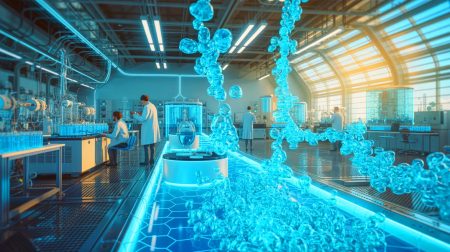| IN A NUTSHELL |
|
The quest for sustainable energy sources is at the forefront of scientific research, and the latest breakthrough comes from the University of Alberta. Researchers there have developed an innovative method to harness diffuse sunlight and common materials to split water into hydrogen and oxygen. This discovery holds the potential to revolutionize how we produce clean and energy-dense fuel for future generations. By utilizing sunlight directly, this method addresses the inefficiencies found in traditional approaches, presenting a more cost-effective and environmentally friendly solution.
Revolutionizing Hydrogen Production
At the heart of the University of Alberta’s breakthrough is a remarkable process that uses sunlight, urea, and nanowires to produce hydrogen. Traditionally, hydrogen is generated through electrolysis, powered by electricity from solar panels, a method plagued by high costs and energy inefficiency. However, the new approach bypasses these drawbacks by employing sunlight directly in the water-splitting process. The key lies in the use of carbon nitride, a material derived from urea, which absorbs sunlight and energizes its electrons, creating electron-hole pairs.
These pairs are kept separate by adding titanium dioxide, allowing the electrons to react with protons to form hydrogen gas, while the holes combine with hydroxyl ions to produce oxygen gas. Notably, this innovative system can function even on cloudy days, thanks to nanowires that capture sunlight from various angles. The result is a more efficient, scalable, and environmentally friendly method of generating hydrogen fuel.
Environmental and Economic Benefits
The potential impact of this new hydrogen production method extends beyond energy efficiency. By eliminating the need for silicon solar panels, which are costly and environmentally taxing to produce, the University of Alberta’s approach offers a cleaner alternative. The materials involved are abundant and inexpensive, making the process economically viable on a large scale. Furthermore, the production of hydrogen gas itself serves as energy storage, reducing reliance on bulky and expensive batteries.
This development holds promise for enhancing energy independence, as nations currently dependent on silicon imports from countries like China and Russia can leverage their resources to produce clean energy locally. The method’s adaptability is also noteworthy, with potential modifications to use melamine instead of urea, and even produce hydrogen from methanol, further broadening its applicability.
On the Horizon: Commercial Viability
The University of Alberta team, led by Karthik Shankar, envisions the commercial application of this groundbreaking technology within the next three to five years. By directly harnessing sunlight to generate hydrogen, the method circumvents substantial energy losses associated with conventional electrolysis. The team is actively exploring alternative materials and processes to enhance the system’s efficiency and versatility.
The implications for global energy markets are significant, as this technology could democratize access to clean energy, enabling countries to harness their resources effectively. The potential for adaptation to various chemical sources, such as methanol, adds another layer of utility, particularly in regions where water scarcity is a concern. These advancements underscore the transformative power of scientific innovation in addressing pressing environmental challenges.
The Road Ahead for Sustainable Energy
As the University of Alberta researchers continue refining their method, the scientific community and industry stakeholders eagerly anticipate the shift toward a hydrogen-centric energy landscape. The study’s publication in the Journal of the American Chemical Society highlights its credibility and potential impact. By emphasizing efficiency, scalability, and environmental benefits, this breakthrough sets the stage for a clean energy revolution.
As nations worldwide grapple with the challenges of climate change and energy security, innovative solutions like this offer a beacon of hope. The prospect of harnessing common materials and sunlight to produce clean fuel is both exciting and promising. How will the global energy landscape evolve as these technologies reach maturity, and what role will hydrogen play in shaping the future of sustainable energy?
Did you like it? 4.5/5 (28)







Wow, using sunlight and urine to produce hydrogen? That’s a real “pee-ce of work”! 🚽
Is this really a breakthrough, or just another impractical idea?
Hats off to the researchers! This could change the way we think about renewable energy.
What happens to the byproducts of this process? Are they harmful?
Sounds like a novel idea, but how scalable is it for industrial use?
Can this method work in cold climates where sunlight is limited?
Using pee to save the planet? I’m game! 😂
Could this technology help reduce our dependence on fossil fuels?
Looks promising, but how long before we see it in action?
Any chance this tech could be adapted for household use?
Is the hydrogen produced pure enough for industrial applications?
Sounds too good to be true. What’s the catch?
How efficient is this method compared to traditional hydrogen production?
Bravo! Will this help reduce the carbon footprint of hydrogen production?
What are the potential risks associated with using nanowires?
Are there any plans to pilot this technology in real-world settings?
Does this mean we could eventually power our homes with urine? 🤔
How does this technology compare to other renewable energy sources?
The future of energy looks bright, thanks to these innovative scientists!
Is the process affected by the quality of the urine or water used?
Can’t wait to see this tech in action! Big thumbs up to the researchers! 👍
Can this innovation be integrated with existing energy infrastructure?
Are there any ethical considerations when using biological waste like urine?
What’s next, powering cars with sweat? 😅